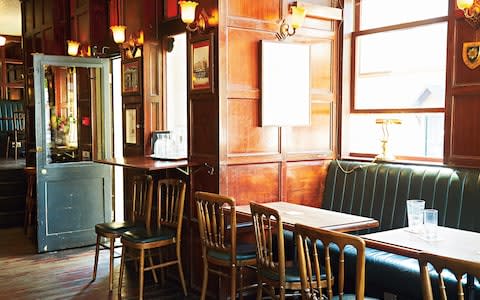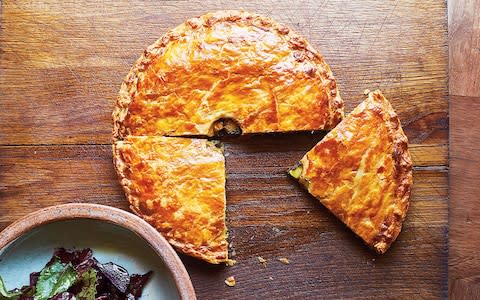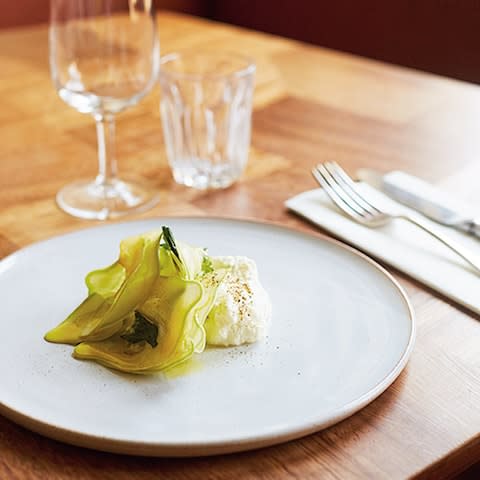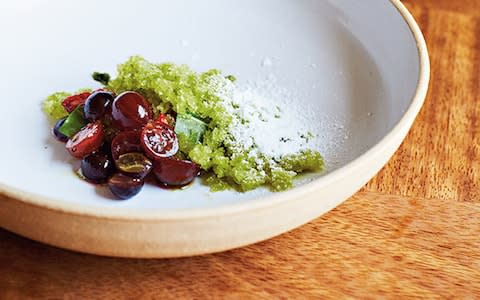How pints and polytunnels made this Michelin Pub of the Year a success

In the kitchen of the Marksman in Hackney, there is palpable excitement when a vegetable delivery arrives from Organiclea. ‘It’s picked in the morning and delivered that evening,’ says chef Tom Harris, ‘and is extraordinarily fresh compared with stuff we get from France or Italy, where it’s been picked five days earlier, then left in a cold store before being brought to us.’
Organiclea, a workers’ co-operative that grows food on the edge of Epping Forest, on the very outskirts of Greater London, was first established in 2001. Set over 12 acres, it comprises orchards, a vineyard, salad terraces, a wildlife ‘corridor’ and glasshouses, as well as classrooms for both adult and child education.
Clouds of cabbage whites hover over soft fruit, and woodpeckers can be heard tapping in the distance. There is a bucolic wildness to the site. ‘If you hang around in the evening, you’ll see families of muntjac deer,’ says Danny Fisher, the organisation’s produce coordinator.

Half of the stuff grown there, all organic, supplies the 500 or so vegetable and fruit boxes that Organiclea delivers locally, and the remaining half goes to London restaurants including the Clove Club and the Salt Yard Group. Its biggest customer by far, though, is the Marksman, an award-winning Hackney pub run by chef-owners Jon Rotheram and Tom Harris.
Last year the Marksman won Michelin Pub of the Year – the first London pub to do so
On a visit to the glasshouses at Organiclea, where 15 types of tomato and more than 55 varieties of chilli are growing, they are greeted by a heady scent of green vines. ‘That’s your summer squash,’ says Fisher, pointing to an overgrown corner. ‘They’ve gone absolutely berserk in the past week.’
Chef Harris relishes the seasonal challenges that Organiclea brings. ‘You don’t see patty pans [small, scalloped-edged squashes] very often,’ he says, ‘and because I know these guys are growing them, I would rather buy from here than from the market.’
‘They look so pretty when you cut them,’ adds Rotheram. ‘We’re just going to dress them with some preserved lemon and mint.’

After buying the Marksman in 2015 and reopening it following a sensitive restoration, Harris, 43, and Rotheram, 40, quickly won acclaim for their iconic British dishes with clever twists, from beef and barley buns to brown butter and honey tart. Last year the Marksman won Michelin Pub of the Year – the first London pub to do so.
Fifty per cent of the menu at the Marksman features produce from Organiclea: ‘We saw what they were doing and said we really wanted to support these guys, and that we’d try to dictate our menus around what they do,’ Harris says.
At the start of the year, they sit down with Fisher to agree on a planting plan, and then call every three or four weeks, when they change their menu, to see what produce is at its best.
‘It’s very bespoke,’ Harris explains. ‘Danny knows that instead of planting a small patch, he’ll plant a whole row for the Marksman, because he knows we’ll take it. That makes what we do easier, because we’re not reliant on market produce.’

Organiclea also gives the Marksman access to ingredients that would otherwise be impossible to source – from nettles, mustard leaves and turnip tops, to sour cherries, worcesterberries and tayberries. ‘I said to Danny, “Are you making it up? I’ve never heard of a tayberry,”’ says Harris, laughing.
The pair have retained their customers, from Terry the window cleaner to Rex the banker
Unsurprisingly for two chefs who met while working at Fergus Henderson’s St John restaurant more than 15 years ago, a key focus has always been on provenance. ‘I think it’s quite nice to see what we fell in love with at St John,’ Rotheram explains. ‘That ethos of food – how you try to use everything, how you’re not afraid to just leave something alone when it’s beautiful – you can see it’s in our DNA.’
Inspiration also comes from traditional English food writers such as Jane Grigson, and Dorothy Hartley, who wrote Food in England in 1954. ‘Hartley travelled the whole of the country on her own, meeting farmers,’ says Rotheram, ‘sometimes sleeping in hedgerows.’
He and Harris are on a mission to restore the reputation of British food. ‘We want to bring it back from the scorn it is held in,’ he says. ‘You go to Madrid, you eat Spanish food; you go to Paris, you eat French food. You come to London, you eat Thai food, Jamaican food. You’d be hard-pressed to find an English restaurant.’

When the opportunity arose to take over the Marksman – a pub they both knew well, as they live locally – they knew they had to tread carefully, to maintain the balance between its being a much-loved pub that has been trading since 1865 and whose regulars had been coming for 30 years, and its becoming a foodie destination. ‘We didn’t want to be a pub that was essentially a restaurant, where you can’t just come in and have a pint,’ Harris says.
At first glance, the pub’s dark Victorian wood panelling, banquettes and engraved mirrors appear refreshingly unmodernised, but in fact the pair made subtle changes – from updating the banquettes from vinyl to leather, to getting the original ‘cheap conference chairs’ remade in oak. ‘That continuity was really important to us,’ Harris says.

The formula has clearly worked: in addition to winning accolades for their food, the pair have managed to retain their wide customer demographic, from Terry the window cleaner, who comes in for a pint after his round, to Rex the banker. ‘Pubs should be a microcosm of London life,’ Harris says.
In addition to planning a Marksman cookbook (covering everything from how to preserve and pickle, to the history of certain dishes), they would love to open more pubs. ‘But I don’t want us to open pubs that just look the same, like a chain,’ Rotheram says. ‘Each one would look different.’
For now, though, the visit to Organiclea has sparked a more immediate idea. ‘We’d really like to be part of the outreach and school work they do here,’ Harris says. ‘They’re doing a crowdfunding campaign [to raise money for an outdoor classroom], and when we walked into the glasshouse today and saw the chairs, we thought, “We want to do dinner in here.” That would be amazing.’
Chard and Spenwood pie

Spenwood is a British hard sheep’s milk cheese; you could use a really nice cheddar or gouda. We always suggest making the pastry from scratch, but you can also buy ready-made puff pastry. The onion purée and the chard can be made the day before. You will need a 22cm tart ring.
SERVES
4-6
INGREDIENTS
For the pastry
250g unsalted butter, plus extra for greasing
400g plain flour, plus extra for dusting
5g salt
250g crème fraîche
1 egg, beaten with a touch of milk
For the filling
2 onions
100g unsalted butter
1 sprig of thyme
2 bay leaves
1kg rainbow chard
100ml olive oil
1 garlic clove
For the cheese sauce
25g butter
25g plain flour
400ml milk
100g Spenwood cheese
METHOD
To start the pastry, chop the butter into dice and mix with the flour and salt to a crumble, then add the crème fraîche and bind together. Leave to rest for one hour.
Roll out the pastry on a lightly floured worktop into one 24cm circle and one 22cm circle (for the pie lid).
Butter the tart ring and dust with flour on a baking sheet, then line with the larger pastry circle and leave both the case and the lid to cool in the fridge until needed.
For the filling, slice the onions thinly and cook in a lidded pan with the butter, thyme and one bay leaf. Cook slowly until soft, then remove the bay and thyme, and blitz in a food processor until smooth and purée-like. Leave to chill.
Chop the rainbow chard very finely, as you would parsley. Cook in a pan with the olive oil, garlic and a bay leaf until soft. Drain any excess juice from the chard to ensure the pastry stays crisp.
Preheat the oven to 190C/170C fan/gas mark 5.
To make the cheese sauce, first make a roux. Melt the butter in a pan and add the flour, cooking and stirring until it becomes biscuity. Take off the heat and gradually stir in the milk to get a smooth sauce. Return to the heat for 10 minutes. Sit the cheese in the pan and allow it to melt.
Assemble the pie with three layers: take the pastry case out of the fridge and spread the onion purée over the base. Follow with layers of first the chard mixture and then the cheese sauce. Place the pie lid on top, pressing it to join the edges, brush with the egg-milk wash, and prick a hole in the middle to release steam.
Bake in the oven for 40-50 minutes, or until golden brown.
Summer squash and curd

This recipe uses ewe’s milk curd. You can easily replace this with a really good buffalo ricotta, and if you can’t find summer squashes, you can use courgettes.
SERVES
4-6 as a starter
INGREDIENTS
juice of ½ lemon
100ml olive oil
2 large summer squashes
200g sheep’s milk curd
100ml whole milk, or as needed
10g picked mint leaves, torn
¼ preserved lemon, rind only, sliced into thin strips
METHOD
Make the vinaigrette by whisking together the lemon juice and olive oil with some salt and pepper to taste.
Slice the summer squashes as thinly as you can. A mandolin is good for this.
Put the curd in a bowl and whip with the milk so it becomes soft and creamy. You are trying for an almost whipped-cream consistency. Add more milk to loosen the curd if needed.
Dress your squash in the vinaigrette with the mint and the preserved-lemon strips. Serve with the whipped curd.
Iced sorrel, jostaberries and tayberries

This recipe uses berries from Organiclea, but they can be easily replaced with raspberries or blueberries.
SERVES
4
INGREDIENTS
400g sugar
100g liquid glucose
200g sorrel
500ml apple juice
½ tsp citric acid, or lemon juice
1 punnet of jostaberries
1 punnet of tayberries
squeeze of lemon
1 tbsp runny honey
1 shop-bought meringue nest
METHOD
Start by making a syrup. Put the sugar and glucose into a pan with 500ml of water and bring up to the boil, then remove from the heat and leave to cool.
Keeping back a few of the sorrel leaves for serving, blend the rest with the apple juice and citric acid or lemon juice in a food processor.
Mix the syrup and the sorrel-apple juice together and place in a container that can easily fit into the freezer.
Freeze, uncovered, for about one hour, until crystals start to form around the edges. With a fork, stir the edges into the centre and mash well, then return to the freezer until crystals start forming again. Stir and refreeze as often as you can, until the sorrel ice is frozen all over.
Fork the granita up roughly when you serve it.
Slice the berries in half and dress in a bowl with a squeeze of lemon juice, a drizzle of honey and some freshly chopped sorrel.
Serve in chilled bowls with the sorrel granita, and grate some meringue over the top.


 Yahoo News
Yahoo News 
